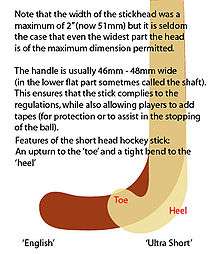Hockey stick

A hockey stick is a piece of equipment used in field hockey, ice hockey , roller hockey or underwater hockey to move the ball or puck.
Field hockey

Field hockey sticks have an end which varies in shape, often depending on the players position. In general there are four main variations on head:
The 'shorti' is mainly used by players wishing extreme control over the ball, and increase their maneuverability. This specific head is most associated with the mid-field position. (or center for Ice Hockey)
The 'Midi' is used by players who will be hitting the ball often and need to be strong on their 'reverse side'. This specific head is most associated with the striker, or 'up-front' position.
The 'Maxi' is similar to the 'Midi' as it has an increased surface area which is useful for hitting. However its strength allows it to be used much more effectively for stopping the ball. This head is used by 'defenders' and 'attackers'.
The 'J Hook' again has a large surface area. However does not have the effectiveness of the 'Midi' for striking the ball, it has an increased thickness making it ideal for stopping the ball. This head is most commonly used by 'defenders'. Field hockey sticks vary widely in length, ranging from 26" to 38.5", and from £30-£370. The main brands of sticks include TK, Grays, Slazenger, Byte, Kookaburra, Malik, Dita, Voodoo, Adidas, Gryphon, UberHockey, Woodworm, Brabo, Mercian, Mazon, Zoppo, Tempest, Matador, King Karachi, NedStar, The Indian Maharadja, Stag, Wasa, No Fear, BHP, Taurus, Wasp, Princess, IHSAN, Mohinder, Chryso, Piranha, Rage, Sachin and Edge.
The size of the stick that is most effective for a specific player is judged by that players height. A 28" stick would be used by a player under 4' most commonly, whereas a 38" stick would be used mainly by players over 5'10". However 'defenders' often like to have a longer stick than 'attackers' as this can be used for a greater reach when stopping a moving ball. The 'attackers' prefer a shorter stick as it allows greater control of the ball.
Ice hockey

Sticks are approximately 150–200 cm long, composed of a long, slender shaft and a flat extension at one end called the blade. The curved part where the blade and the shaft meet is called a taper. The blade is the part of the stick used to contact the puck, and is typically 10 to 15 inches long. Stick dimensions can vary widely, as they are usually built to suit a particular player's size. Taller players usually use longer sticks. There is some variance on the height of the stick in preference of the player. A player favouring fast stick handling and good puck control would opt for a shorter stick, while a player wanting a harder, faster shot would opt for a longer stick. Oftentimes defenseman use longer sticks than forwards. The blade's angle depends on the height of the stick, but is usually positioned around 45 degrees. The blade is often curved in the direction toward which the skater moves forward, to aid in retaining or lifting the puck off the playing surface. This curvature of the stick greatly increases the speed of the player's shot. The downside to the increased curvature is that shots on the backhand side of the stick are more difficult to execute and are less accurate and/or not as powerful. The shaft of the stick is fairly rigid, but it has some flexibility to benefit some shots. Common ice hockey shots include: wrist shot, slap shot, snap shot and backhand.
Sticks have traditionally been made from wood, but in recent years, sticks made of more expensive materials such as aluminum, Aramid (kevlar), fiberglass, carbon fiber, and other composite materials have become common. In addition to weighing less, composite sticks can be manufactured with more consistent flexibility properties than their wooden counterparts. They also do not have the natural variations that wooden sticks possess therefore a batch of the same sticks will all perform roughly the same. There are die-hard NHL professionals that still like the feel of wood sticks such as Paul Stastny (Son of ice hockey Hall-of-Famer Peter Stastny). Some of these sticks have replaceable wood or composite blades, while others are one piece sticks without a replaceable blade. Composite sticks, despite their greater expense, are now commonplace at nearly all competitive levels of the sport, including youth ice hockey. Some of the top brands of composite sticks include Bauer, Easton, Reebok/CCM, and Warrior. Many professionals are using composite stick technology rather than wooden sticks. These new sticks are lighter and provide a quicker release of the puck, resulting in a harder, more accurate shot. Although the new materials do enable harder shots, the improved durability and lighter materials can make the transition from wooden to composite stick more difficult for less experienced players. A shortcut used by numerous players is to use a weighted system, such as kwik hands,[1] to quickly adjust to the new sticks. More expensive ice hockey sticks (such as the Bauer Vapor APX 2, Bauer Supreme TotalOne NXG, Bauer Nexus 8000, Reebok 20k, Reebok Ribcore, Easton Stealth RS 2, Easton V9 & V9E, Warrior Covert DX1 ) usually are the lightest sticks on the market (390-470 grams in a senior stick). In addition to the increased torque that these composite sticks possess, the sticks do not warp or absorb moisture like their wooden counterparts.
Roller hockey
In the event of roller hockey, one-piece sticks are usually the same as ice hockey sticks. But when graphite shafts are used with replacement blades, it's quite common for the replacement blades to be made of mainly fiberglass with a narrow wood core. Fiberglass shaves down nicely over time on concrete, sport court, and blacktop surfaces when traditional wooden ice hockey replacement blades are more likely to splinter, split and/or crack on those surfaces.
Underwater hockey
The stick (also referred to as a 'bat' or 'pusher') for this sport is relatively short compared to that for Field/Ice/Roller hockey, and should be coloured either white or black in its entirety to indicate the player's team. The stick may only be held in one hand, which is usually determined by the player's handedness, although players may swap hands during play. The shape of the stick may affect playing style and is often a very personal choice. A wide variety of stick designs are allowed within the constraints of the rules of the game, the principal rules being that the stick must fit into a box of 100x50x350mm and that the stick must not be capable of surrounding the puck or any part of the hand. A rule concerning the minimum radius of edges tries to address the risk that the stick might become more of a weapon than a playing tool. Construction materials may be of wood or plastics and current rules now supersede those that previously required sticks to be homogeneous, although they almost always are anyway. Many players of UWH manufacture their own sticks to their preferred shape and style, although there are increasingly more mass-produced designs to suit the majority (such as Bentfish, Britbat, CanAm, Dorsal, Stingray etc.).
In culture
In the dances Cha Cha Cha and Rumba, a "hockey stick" is a figure in which the woman moves along a straight line, with an angled turn at the end.[2][3]
References
- ↑ Improveyourhockey.com
- ↑ DanceSport BC (download "Syllabus: International Latin")
- ↑ List of Cha Cha Cha moves